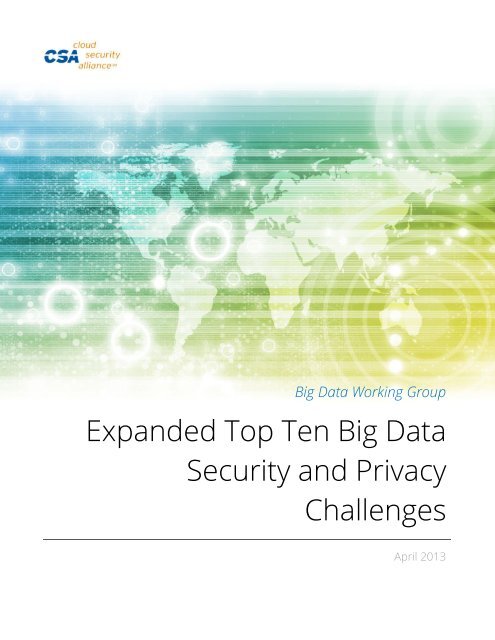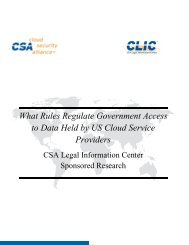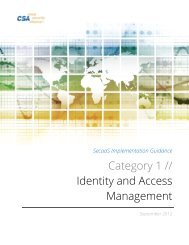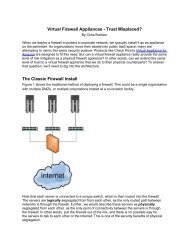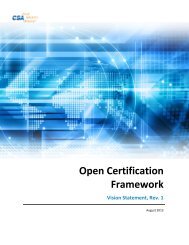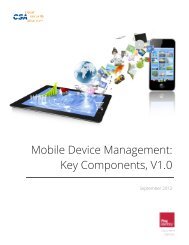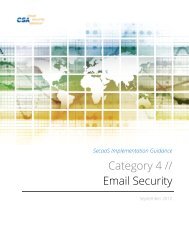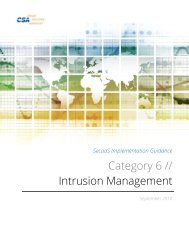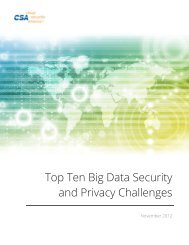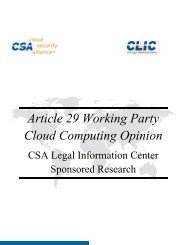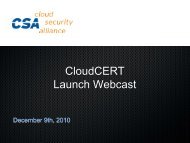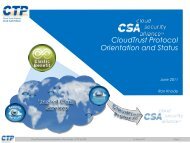Expanded Top Ten Big Data Security and Privacy Challenges
Expanded Top Ten Big Data Security and Privacy Challenges
Expanded Top Ten Big Data Security and Privacy Challenges
You also want an ePaper? Increase the reach of your titles
YUMPU automatically turns print PDFs into web optimized ePapers that Google loves.
<strong>Big</strong> <strong>Data</strong> Working Group<strong>Exp<strong>and</strong>ed</strong> <strong>Top</strong> <strong>Ten</strong> <strong>Big</strong> <strong>Data</strong><strong>Security</strong> <strong>and</strong> <strong>Privacy</strong><strong>Challenges</strong>April 2013
CLOUD SECURITY ALLIANCE <strong>Exp<strong>and</strong>ed</strong> <strong>Top</strong> <strong>Ten</strong> <strong>Big</strong> <strong>Data</strong> <strong>Security</strong> <strong>and</strong> <strong>Privacy</strong> <strong>Challenges</strong>, April 2013vIntroductionThe term “<strong>Big</strong> <strong>Data</strong>” refers to the massive amounts of digital information companies <strong>and</strong> governments collectabout human beings <strong>and</strong> our environment. The amount of data generated is expected to double every two years,from 2500 exabytes in 2012 to 40,000 exabytes in 2020 [56]. <strong>Security</strong> <strong>and</strong> privacy issues are magnified by thevolume, variety, <strong>and</strong> velocity of <strong>Big</strong> <strong>Data</strong>. Large-scale cloud infrastructures, diversity of data sources <strong>and</strong> formats,the streaming nature of data acquisition <strong>and</strong> high volume inter-cloud migration all create unique securityvulnerabilities.It is not merely the existence of large amounts of data that is creating new security challenges. <strong>Big</strong> <strong>Data</strong> has beencollected <strong>and</strong> utilized by many organizations for several decades. The current use of <strong>Big</strong> <strong>Data</strong> is novel becauseorganizations of all sizes now have access to <strong>Big</strong> <strong>Data</strong> <strong>and</strong> the means to employ it. In the past, <strong>Big</strong> <strong>Data</strong> was limitedto very large organizations such as governments <strong>and</strong> large enterprises that could afford to create <strong>and</strong> own theinfrastructure necessary for hosting <strong>and</strong> mining large amounts of data. These infrastructures were typicallyproprietary <strong>and</strong> were isolated from general networks. Today, <strong>Big</strong> <strong>Data</strong> is cheaply <strong>and</strong> easily accessible toorganizations large <strong>and</strong> small through public cloud infrastructure. Software infrastructures such as Hadoop enabledevelopers to easily leverage thous<strong>and</strong>s of computing nodes to perform data-parallel computing. Combined withthe ability to buy computing power on-dem<strong>and</strong> from public cloud providers, such developments greatly acceleratethe adoption of <strong>Big</strong> <strong>Data</strong> mining methodologies. As a result, new security challenges have arisen from the couplingof <strong>Big</strong> <strong>Data</strong> with public cloud environments characterized by heterogeneous compositions of commodity hardwarewith commodity operating systems, <strong>and</strong> commodity software infrastructures for storing <strong>and</strong> computing on data.As <strong>Big</strong> <strong>Data</strong> exp<strong>and</strong>s through streaming cloud technology, traditional security mechanisms tailored to securingsmall-scale, static data on firewalled <strong>and</strong> semi-isolated networks are inadequate. For example, analytics foranomaly detection would generate too many outliers. Similarly, it is unclear how to retrofit provenance in existingcloud infrastructures. Streaming data dem<strong>and</strong>s ultra-fast response times from security <strong>and</strong> privacy solutions.The purpose of this paper is to highlight the top ten <strong>Big</strong> <strong>Data</strong> security <strong>and</strong> privacy challenges according topractitioners. To do so, the working group utilized a three-step process to arrive at the top challenges in <strong>Big</strong> <strong>Data</strong>:1. The working group interviewed Cloud <strong>Security</strong> Alliance (CSA) members <strong>and</strong> surveyed security-practitioneroriented trade journals to draft an initial list of high priority security <strong>and</strong> privacy problems.2. The working group studied published solutions.3. The working group characterized a problem as a challenge if the proposed solution did not cover theproblem scenarios.Based on this three-step process, the working group compiled the top ten challenges to <strong>Big</strong> <strong>Data</strong> security <strong>and</strong>privacy:1. Secure computations in distributed programming frameworks2. <strong>Security</strong> best practices for non-relational data stores3. Secure data storage <strong>and</strong> transactions logs© 2013 Cloud <strong>Security</strong> Alliance - All Rights Reserved. 5
CLOUD SECURITY ALLIANCE <strong>Exp<strong>and</strong>ed</strong> <strong>Top</strong> <strong>Ten</strong> <strong>Big</strong> <strong>Data</strong> <strong>Security</strong> <strong>and</strong> <strong>Privacy</strong> <strong>Challenges</strong>, April 2013v4. End-point input validation/filtering5. Real-time security monitoring6. Scalable <strong>and</strong> composable privacy-preserving data mining <strong>and</strong> analytics7. Cryptographically enforced data centric security8. Granular access control9. Granular audits10. <strong>Data</strong> provenanceFigure 1 depicts the top ten challenges in the <strong>Big</strong> <strong>Data</strong> ecosystem.Figure 1: <strong>Top</strong> <strong>Ten</strong> <strong>Security</strong> <strong>and</strong> <strong>Privacy</strong> <strong>Challenges</strong> in the <strong>Big</strong> <strong>Data</strong> EcosystemThe challenges may be organized into four aspects of the <strong>Big</strong> <strong>Data</strong> ecosystem, as depicted in Figure 2:1. Infrastructure <strong>Security</strong>2. <strong>Data</strong> <strong>Privacy</strong>3. <strong>Data</strong> Management4. Integrity <strong>and</strong> Reactive <strong>Security</strong>© 2013 Cloud <strong>Security</strong> Alliance - All Rights Reserved. 6
CLOUD SECURITY ALLIANCE <strong>Exp<strong>and</strong>ed</strong> <strong>Top</strong> <strong>Ten</strong> <strong>Big</strong> <strong>Data</strong> <strong>Security</strong> <strong>and</strong> <strong>Privacy</strong> <strong>Challenges</strong>, April 2013vInfrastructuresecurity<strong>Data</strong> <strong>Privacy</strong><strong>Data</strong>ManagementIntegrity <strong>and</strong>Reactive<strong>Security</strong>Secure Computationsin DistributedProgrammingFrameworks<strong>Privacy</strong> Preserving<strong>Data</strong> Mining <strong>and</strong>AnalyticsSecure <strong>Data</strong> Storage<strong>and</strong> Transaction LogsEnd-point validation<strong>and</strong> filtering<strong>Security</strong> BestPractices for Non-Relational <strong>Data</strong>StoresCryptographicallyEnforced <strong>Data</strong> Centric<strong>Security</strong>Granular AuditsReal time <strong>Security</strong>MonitoringGranular AccessControl<strong>Data</strong> ProvenanceFigure 2: Classification of the <strong>Top</strong> 10 <strong>Challenges</strong>In order to secure the infrastructure of <strong>Big</strong> <strong>Data</strong> systems, the distributed computations <strong>and</strong> data stores must besecured. To secure the data itself, information dissemination must be privacy-preserving, <strong>and</strong> sensitive data mustbe protected through the use of cryptography <strong>and</strong> granular access control. Managing the enormous volume ofdata necessitates scalable <strong>and</strong> distributed solutions for both securing data stores <strong>and</strong> enabling efficient audits <strong>and</strong>data provenance. Finally, the streaming data emerging from diverse end-points must be checked for integrity <strong>and</strong>can be used to perform real time analytics for security incidents to ensure the health of the infrastructure.Solving security <strong>and</strong> privacy challenges typically requires addressing three distinct issues:1. Modeling: formalizing a threat model that covers most of the cyber-attack or data-leakage scenarios2. Analysis: finding tractable solutions based on the threat model3. Implementation: implementing the solution in existing infrastructuresIn this paper, we provide a brief description of each challenge, review usage of <strong>Big</strong> <strong>Data</strong> that may be vulnerable,<strong>and</strong> summarize existing knowledge according to the modeling, analysis, <strong>and</strong> implementation for each challenge.© 2013 Cloud <strong>Security</strong> Alliance - All Rights Reserved. 7
CLOUD SECURITY ALLIANCE <strong>Exp<strong>and</strong>ed</strong> <strong>Top</strong> <strong>Ten</strong> <strong>Big</strong> <strong>Data</strong> <strong>Security</strong> <strong>and</strong> <strong>Privacy</strong> <strong>Challenges</strong>, April 2013v1.0 Secure Computations in DistributedProgramming FrameworksDistributed programming frameworks utilize parallel computation <strong>and</strong> storage to process massive amounts ofdata. For example, the MapReduce framework splits an input file into multiple chunks. In the first phase ofMapReduce, a Mapper for each chunk reads the data, performs some computation, <strong>and</strong> outputs a list of key/valuepairs. In the next phase, a Reducer combines the values belonging to each distinct key <strong>and</strong> outputs the result.There are two major attack prevention measures: securing the mappers <strong>and</strong> securing the data in the presence ofan untrusted mapper.1.1 Use CaseUntrusted mappers can be altered to snoop on requests, alter MapReduce scripts, or alter results. The mostdifficult problem is to detect mappers returning incorrect results, which will, in turn, generate incorrect aggregateoutputs. With large data sets, it is nearly impossible to identify malicious mappers that may create significantdamage, especially for scientific <strong>and</strong> financial computations.Retailer consumer data is often analyzed by marketing agencies for targeted advertising or customer-segmenting.These tasks involve highly parallel computations over large data sets <strong>and</strong> are particularly suited for MapReduceframeworks such as Hadoop. However, the data mappers may contain intentional or unintentional leakages. Forexample, a mapper may emit a unique value by analyzing a private record, undermining users’ privacy.1.2 ModelingThe threat model for mappers has three major scenarios:1. Malfunctioning Compute Worker Nodes – Workers assigned to mappers in a distributed computationcould malfunction due to incorrect configuration or a faulty node. A malfunctioning Worker could returnincorrect output from the mapper, which may compromise the integrity of the aggregate result. Such aWorker may also be modified to leak users’ confidential data or profile users’ behaviors or preferencesfor privacy mining.2. Infrastructure Attacks – Compromised Worker nodes may tap the communication among other Workers<strong>and</strong> the Master with the objective of replay, Man-In-the-Middle, <strong>and</strong> DoS attacks to the MapReducecomputations.3. Rogue <strong>Data</strong> Nodes – Rogue data nodes can be added to a cluster, <strong>and</strong> subsequently receive replicateddata or deliver altered MapReduce code. The ability to create snapshots of legitimate nodes <strong>and</strong> reintroducealtered copies is a straightforward attack in cloud <strong>and</strong> virtual environments <strong>and</strong> is difficult todetect.© 2013 Cloud <strong>Security</strong> Alliance - All Rights Reserved. 8
CLOUD SECURITY ALLIANCE <strong>Exp<strong>and</strong>ed</strong> <strong>Top</strong> <strong>Ten</strong> <strong>Big</strong> <strong>Data</strong> <strong>Security</strong> <strong>and</strong> <strong>Privacy</strong> <strong>Challenges</strong>, April 2013v1.3 AnalysisBased on the threat model outlined above, there are two dimensions of analysis: ensuring trustworthiness ofmappers <strong>and</strong> securing the data despite untrusted mappers.For ensuring the trustworthiness of mappers, there are two techniques: trust establishment <strong>and</strong> M<strong>and</strong>atoryAccess Control (MAC) [1].1. Trust establishment has two steps: initial trust establishment followed by periodic trust update. When aWorker sends a connection request to the Master, the Master authenticates the Worker. Onlyauthenticated Workers with expected properties will be assigned a mapper task. Following the initialauthentication, the security properties of each Worker are checked periodically for conformance withpredefined security policies.2. MACensures access to the files authorized by a predefined security policy. MAC ensures integrity of inputsto the mappers, but does not prevent data leakage from the mapper outputs.In order to prevent information leakage from mapper outputs, data de-identification techniques are required toprevent violation of privacy through the output of aggregate computations. A mathematically rigorous definitionfor data de-identification is the notion of differential privacy, which is achieved by adding r<strong>and</strong>om noise to theoutput of a computation. However, it is difficult to prove that a particular technique is privacy-preserving.1.4 ImplementationMAC is implemented in Airavat [1] by modifying the MapReduce framework, the distributed file system, <strong>and</strong> theJava virtual machine with SELinux as the underlying operating system. MAC in SELinux ensures that untrusted codedoes not leak information via system resources. However it cannot guarantee privacy for computations based onoutput keys produced by untrusted mappers. To prevent information leakage through the outputs, it relies on arecently developed de-identification framework of differential privacy based on function sensitivity. In the contextof mappers, function sensitivity is the degree of influence that an input can have the mapper output. Estimatingthe sensitivity of arbitrary untrusted code is difficult.There are two problems to be tackled with the solutions outlined above for widespread practical adoption:1. Performance penalties due to imposing MAC2. Limitations of differential privacy in providing guarantees© 2013 Cloud <strong>Security</strong> Alliance - All Rights Reserved. 9
CLOUD SECURITY ALLIANCE <strong>Exp<strong>and</strong>ed</strong> <strong>Top</strong> <strong>Ten</strong> <strong>Big</strong> <strong>Data</strong> <strong>Security</strong> <strong>and</strong> <strong>Privacy</strong> <strong>Challenges</strong>, April 2013v2.0 <strong>Security</strong> Best Practices for Non-Relational <strong>Data</strong>StoresThe security infrastructures of non-relational data stores popularized by NoSQL databases are still evolving [2].For instance, robust solutions to NoSQL injection are still not mature. Each NoSQL database was built to tackledifferent challenges posed by the analytics world, <strong>and</strong> security was never addressed during the design stage.Developers using NoSQL databases usually embed security in the middleware. NoSQL databases do not provideany support for explicitly enforcing security in the database. However, clustering aspects of NoSQL databases poseadditional challenges to the robustness of such security practices.2.1 Use CaseCompanies dealing with large unstructured data sets may benefit by migrating from a traditional relationaldatabase (RDB) to a NoSQL database. NoSQL databases accommodate <strong>and</strong> process huge volumes of static <strong>and</strong>streaming data for predictive analytics or historical analysis. Threat trees derived from detailed threat analysisusing threat-modeling techniques on widely used NoSQL databases demonstrate that NoSQL databases only havea very thin security layer, compared to traditional RDBs. In general, the security philosophy of NoSQL databasesrelies on external enforcement mechanisms. To reduce security incidents, the company must review securitypolicies for the middleware <strong>and</strong>, at the same time, toughen the NoSQL database itself to match the security RDBswithout compromising on its operational features. The capability of NoSQL databases to perform analytics overunstructured <strong>and</strong> structured data at ease is in no way comparable to an RDB’s ability to h<strong>and</strong>le OLTP <strong>and</strong> OLAP(to a large extent with the latest RDBMS versions). However, it is important that security loopholes within NoSQLdatabases are plugged without compromising on its outst<strong>and</strong>ing analytical capabilities.Cloud-based solutions, in which traditional service providers offer Analytics as a Service (AaaS), are based onanalytics frameworks built using a combination of tools capable of h<strong>and</strong>ling both streaming <strong>and</strong> static data, withNoSQL databases used for intermediate data h<strong>and</strong>ling. In such scenarios, several users share the framework,feeding both streaming <strong>and</strong> static data with appropriate connectors through the framework for analytics. Thesedata sets need to be held in a NoSQL database for intermediate processing before the results are pushed to therespective users. With current NoSQL security mechanisms, it is virtually impossible to segregate sensitive datapertaining to different cloud users sharing the framework’s internal NoSQL database.2.2 ModelingThe same architectural flexibility that allows the two notable features of NoSQL, performance <strong>and</strong> scalability,poses the greatest security risk [3]. NoSQL was designed with the vision of tackling large data sets, with limitedemphasis on security [4]. This has caused many critical security flaws in NoSQL, only a few of which are addressedin this paper. Lack of security st<strong>and</strong>ards has caused vendors to develop bottom-up NoSQL solutions <strong>and</strong> addresssecurity issues on an ad-hoc basis. The threat model of NoSQL databases has six major scenarios:© 2013 Cloud <strong>Security</strong> Alliance - All Rights Reserved. 10
CLOUD SECURITY ALLIANCE <strong>Exp<strong>and</strong>ed</strong> <strong>Top</strong> <strong>Ten</strong> <strong>Big</strong> <strong>Data</strong> <strong>Security</strong> <strong>and</strong> <strong>Privacy</strong> <strong>Challenges</strong>, April 2013v2.3 Analysis<strong>Data</strong> integrity needs to be enforced through an application or middleware layer. Passwords should never be leftin the clear while at rest <strong>and</strong> in transit, but instead should be encrypted or hashed using secure hashing algorithms.Similarly, data stored in the database should never be left in the clear. Considering the already weakauthentication <strong>and</strong> authorization techniques employed, it is vital to keep the data encrypted while at rest despitethe associated performance impacts. Hardware appliance-based encryption/decryption <strong>and</strong> bulk file-basedencryption are faster <strong>and</strong> would alleviate some concern about the performance impacts of encryption. Of course,hardware-based encryption is not without its own criticism as it often leads to a vendor lock-in, low-strength keyused in encryption/decryption that can be exploited by attackers. As a result, malicious users who gain access tothe file system could directly extract sensitive data from the file system. In order to maintain confidentiality whilein transit, it is good practice to use SSL/TLS to establish connections between the client <strong>and</strong> the server <strong>and</strong> alsofor communication across participating cluster nodes. Adopting such mechanisms to exchange mutually verifiablekeys <strong>and</strong> establish trust would ensure data confidentiality while data is in transit. The NoSQL architecture shouldsupport pluggable authentication modules with the capacity to enforce security at all levels as the situationdem<strong>and</strong>s.Communication across clusters should also be better controlled so that each node can validate the trust level ofother participating nodes before establishing a trusted communication channel. The utilization of intelligenthashing algorithms can ensure that the data is replicated consistently across nodes, even during node failures. AllNoSQL products/solutions recommend that they be run on a trusted environment, which ensures that only trustedmachines can access the database ports.Appropriate logging mechanisms, on-the-fly log analysis, <strong>and</strong> aggregation <strong>and</strong> application of correlation to loganalysis could expose possible attacks. Applying fuzzing methods (providing invalid, unexpected or r<strong>and</strong>om inputs)can be an ideal method to expose possible vulnerabilities in NoSQL that engages HTTP to establish communicationwith the clients.Appropriate data tagging techniques, with time stamps enforced through intelligent algorithms while piping datafrom its source, will defend against unauthorized modification of data. These techniques will also preserve theauthenticity of the data stored.2.4 ImplementationIt is evident from the threat models <strong>and</strong> analysis that plugging NoSQL holes by wrapping sensitive data within thethin, easily penetrable security layer of web or similar interfaces is insufficient to guarantee the security of theunderlying data [5]. Hiding NoSQL under the secure wrapper of middleware or accessing NoSQL using a frameworklike Hadoop can create a virtual secure layer around the NoSQL perimeter. Object-level security at the collectionorcolumn-level can be induced through the middleware, retaining its thin database layer. Such a methodologywill ensure that there is no direct access to the data <strong>and</strong> that the data is only exposed based on the controlsconfigured within the middleware or framework layer. Cloud-era distributed Hadoop supports strong Kerberosauthentication. Such mechanisms could:© 2013 Cloud <strong>Security</strong> Alliance - All Rights Reserved. 12
CLOUD SECURITY ALLIANCE <strong>Exp<strong>and</strong>ed</strong> <strong>Top</strong> <strong>Ten</strong> <strong>Big</strong> <strong>Data</strong> <strong>Security</strong> <strong>and</strong> <strong>Privacy</strong> <strong>Challenges</strong>, April 2013v1. Prevent malicious user impersonation2. Enforce user authentication on all remote procedure calls (RPCs)3. Prevent user manipulation of group membership by performing group resolution on the Hadoopmasternodes, cluster nodes <strong>and</strong> job tracker4. Ensure proper isolation as map tasks are run under the account of the user who submitted the job.Deploying the middleware layer to encapsulate the underlying NoSQL stratum can be another option toimplement security. Most of the middleware software comes with ready-made support for authentication,authorization <strong>and</strong> access control. In the case of Java, Java Authentication <strong>and</strong> Authorization Services (JAAS) <strong>and</strong>SpringSource, Spring <strong>Security</strong> frameworks are deployed for authentication, authorization <strong>and</strong> access control. Suchan architecture will ensure that any changes to schema, objects <strong>and</strong>/or data are validated, thus gaining bettercontrol while preserving the capabilities of NoSQL [6].In order to maintain performance, the ability to scale to dem<strong>and</strong>, <strong>and</strong> the security of the overall system, it isnecessary to integrate NoSQL into a framework, thereby offloading the security components onto the framework.Such a framework should be tightly coupled with the underlying operating system so that policy-based securitylayers can be burned onto the lower substratum (kernel layer). This will ensure that the missing RBAC can beenforced in order to limit access to the underlying data, preserve the thinness of the database layer, <strong>and</strong> maintainthe analytical capability of NoSQL. Above all, such a mechanism will ensure that the data owners have bettercontrol over their data, thus preventing or exposing insider attacks. This will tighten the security of dataintermediately held for processing in a NoSQL database within a shared framework architecture in which analyticsis offered as a service through one or more cloud service models.As an alternative to vulnerable NoSQL data, encryption provides better protection. Hadoop employs file-layerencryption to provide unswerving protection, irrespective of the operating system, platform or storage type. Withthe availability of products capable of offering encryption, dem<strong>and</strong> for h<strong>and</strong>ling streaming data <strong>and</strong> processingthem in-memory is on the rise. Encryption solutions seem to be a cost effective way to address several of theknown data-security issues.© 2013 Cloud <strong>Security</strong> Alliance - All Rights Reserved. 13
CLOUD SECURITY ALLIANCE <strong>Exp<strong>and</strong>ed</strong> <strong>Top</strong> <strong>Ten</strong> <strong>Big</strong> <strong>Data</strong> <strong>Security</strong> <strong>and</strong> <strong>Privacy</strong> <strong>Challenges</strong>, April 2013v3.0 Secure <strong>Data</strong> Storage <strong>and</strong> Transactions Logs<strong>Data</strong> <strong>and</strong> transaction logs are stored in multi-tiered storage media. Manually moving data between tiers gives theIT manager direct control over exactly what data is moved <strong>and</strong> when. However, as the size of data set continuesto grow exponentially, scalability <strong>and</strong> availability have necessitated auto-tiering for <strong>Big</strong> <strong>Data</strong> storage management.Auto-tiering solutions do not keep track of where the data is stored, which poses new challenges to secure datastorage. New mechanisms are imperative to thwart unauthorized access <strong>and</strong> maintain constant availability.3.1 Use CaseA manufacturer wants to integrate data from different divisions. Some of this data is rarely retrieved, while somedivisions constantly utilize the same data pools. An auto-tier storage system will save the manufacturer money bypulling the rarely utilized data to a lower (<strong>and</strong> cheaper) tier. However, this data may consist of critical informationthat is not regularly accessed (such as R&D results). Since the lower-tier often provides reduced security, thecompany should carefully study tiering strategies. Additionally, the meta-data, i.e. the text log, introduces anotherdimension that needs to be protected. The log poisoning attacks will potentially lead to data inconsistency <strong>and</strong>disputes among users.3.2 ModelingNetwork-based, distributed, auto-tier storage systems are a promising solution that possess advanced featuressuch as transparent service, good scalability <strong>and</strong> elasticity. However, auto-tier storage systems generate newvulnerabilities due to a lack of physical possession, untrusted storage service, or inconsistent security policies. Thethreat model for auto-tier storage systems includes seven major scenarios:1. Confidentiality <strong>and</strong> Integrity – In addition to those attempting to steal sensitive information or damageuser data, storage service providers are also assumed to be untrustworthy third parties. <strong>Data</strong> transmissionamong tiers in a storage system provides clues that enable the service provider to correlate user activities<strong>and</strong> data set. Without being able to break the cipher, certain properties can be revealed.2. Provenance – Due to the extremely large size, it is infeasible to download the entire data set to verify itsavailability <strong>and</strong> integrity. Lightweight schemes are desired to provide verification that is probabilisticallyaccurate <strong>and</strong> incurs low computing <strong>and</strong> communication overhead.3. Availability – Auto-tiering also places challenges on the service providers to guarantee constantavailability. Not only does weaker security at lower tiers risk Denial of Service (DoS) attacks, theperformance gap between lower tiers <strong>and</strong> higher tiers also extends the backup windows during periodsof fast restore <strong>and</strong> disaster recovery.4. Consistency – It is now typical that data flows among tiers <strong>and</strong> is shared by multiple users. To maintainconsistency among multiple duplicates stored at difference locations is non-trivial. Two issues that needto be addressed carefully are write-serializability <strong>and</strong> multi-writer multi-reader (MWMR) problems.© 2013 Cloud <strong>Security</strong> Alliance - All Rights Reserved. 14
CLOUD SECURITY ALLIANCE <strong>Exp<strong>and</strong>ed</strong> <strong>Top</strong> <strong>Ten</strong> <strong>Big</strong> <strong>Data</strong> <strong>Security</strong> <strong>and</strong> <strong>Privacy</strong> <strong>Challenges</strong>, April 2013v5. Collusion Attacks – While a data owner stores the cipher text in an auto-tier storage system <strong>and</strong> distributesthe key <strong>and</strong> permission access to the users, each user is authorized to have access to a certain portion ofthe data set. Also, the service provider cannot interpret the data without the cipher key materials.However, if the service provider colludes with users by exchanging the key <strong>and</strong> data, they will obtain adata set that they are not entitled to.6. Roll-Back Attacks – In a multi-user environment, the service provider can launch roll-back attacks on users.When an updated version of a data set has been uploaded into storage, the service provider can fool theuser by delivering the outdated version. Certain evidence is required to help users ensure that data is upto-date,<strong>and</strong> the user should have the capability of detecting the inconsistency. This is also referred to as“User’s Freshness.”7. Disputes – A lack of recordkeeping will lead to disputes between users <strong>and</strong> the storage service provider,or among users. When data loss or tampering occurs, transmission logs/records are critical to determiningresponsibility. For example, a malicious user outsources data to a storage system. Later, the user reportsdata loss <strong>and</strong> asks for compensation for his claimed loss. In this case, a well-maintained log can effectivelyprevent fraud.3.3 AnalysisIn recent decades, the information assurance <strong>and</strong> cyber infrastructure security fields have developed rapidly.There are now sophisticated techniques to address the security issues listed above. Confidentiality <strong>and</strong> integritycan be achieved with robust encryption techniques <strong>and</strong> message-digests. The exchange of signed message-digestscan be used to address potential disputes [18]. User freshness <strong>and</strong> write-serializability can be solved by periodicaudit [24] <strong>and</strong> chain hash [23] or persistent authenticated dictionary (PAD) [11]. Secure untrusted data repository(SUNDR) can be used to detect fork consistency attack <strong>and</strong> write serializability.Two “lock-free” protocols, linear <strong>and</strong> concurrent, have been proposed to address the problem of single-writemulti-read (SWMR) [21]. However, SWMR is a case-dependent problem <strong>and</strong> is beyond the scope of this paper.Broadcast encryption [14] <strong>and</strong> key rotation [20] can be used to improve scalability. Researchers have proposedtechnologies to h<strong>and</strong>le the provenance issues [22]. <strong>Data</strong> availability can be improved through proof ofretrievability (POR) or provable data possession (PDP) methods with high probability [10], [19].Regarding collusion attacks, as long as the users do not exchange their private keys, a policy-based encryptionsystem (PBES) can successfully guarantee a collusion-free environment [13]. If the users are willing to exchangetheir private keys without exchanging the decrypted content, a mediated decryption system can avoid collusionattacks. If the users are willing to exchange the decrypted contents, digital rights management can preventcollusion attacks. Two non-repudiation protocols have been proposed recently to address disputed issues [16],[17].While it seems that there are techniques for each individual security problem in large scale auto-tier storagesystems, there is no systematic approach to integrate them into a seamless, holistic solution. The non-uniformsecurity policies among different tiers pose an additional challenge to securing inter-tier data transmission. Moreconsiderations are necessary to balance tradeoffs among security, usability, complexity, <strong>and</strong> cost.© 2013 Cloud <strong>Security</strong> Alliance - All Rights Reserved. 15
CLOUD SECURITY ALLIANCE <strong>Exp<strong>and</strong>ed</strong> <strong>Top</strong> <strong>Ten</strong> <strong>Big</strong> <strong>Data</strong> <strong>Security</strong> <strong>and</strong> <strong>Privacy</strong> <strong>Challenges</strong>, April 2013v3.4 ImplementationThe heterogeneity of technologies, varied security policies, <strong>and</strong> cost constraints lead to diverse security strategiesin multitier storage systems. While many structures can be adopted to satisfy general security requirements suchas data confidentiality, integrity, <strong>and</strong> availability, three special issues need more attention:1. Dynamic <strong>Data</strong> Operations – <strong>Data</strong> set in the auto-tier storage system is dynamic because operations suchas modification, duplication, deletion <strong>and</strong> insertion will happen more frequently. An extended dynamicversion of a PDP scheme [12] achieves higher efficiency because it only relies on symmetry-keycryptography. However, since the number of queries is limited, the scheme cannot support fully dynamicdata operations. A formal framework for dynamic provable data possession (DPDP) [15] can be consideredto improve detection probability at the cost of increased server computation burden. An extended versionof the compact POR [26] supports both public verifiability <strong>and</strong> data dynamics in cloud storage, which canbe thought of as a special case of a network-based auto-tier storage system.2. <strong>Privacy</strong> Preservation – It is a trend to outsource verification procedures to a third-party auditor (TPA), <strong>and</strong>the verification protocol is expected to be publicly verifiable. At first glance, privacy preservation seemsto be in conflict with the public verifiability requirement. A privacy-preserving public auditing scheme wasproposed for cloud storage in Wang, et al. [25]. Based on a homomorphic linear authenticator integratedwith r<strong>and</strong>om masking, the proposed scheme is able to preserve data privacy when a TPA audits the dataset stored in the servers at different tiers.3. Secure Manipulations on Encrypted <strong>Data</strong> – Beyond privacy-preserving auditing, today's computing taskoutsourcing requires the capacity to conduct operations on the cipher-text without decryption. The fullyhomomorphic encryption scheme makes these operations possible because more complex functions aresupported [54]. Recent achievements in "Cryptographic Cloud Storage" [55] provide an alternativesolution for cloud platforms by allowing the construction of a secure IaaS storage on top of an untrustedinfrastructure.© 2013 Cloud <strong>Security</strong> Alliance - All Rights Reserved. 16
CLOUD SECURITY ALLIANCE <strong>Exp<strong>and</strong>ed</strong> <strong>Top</strong> <strong>Ten</strong> <strong>Big</strong> <strong>Data</strong> <strong>Security</strong> <strong>and</strong> <strong>Privacy</strong> <strong>Challenges</strong>, April 2013v4.0 End-Point Input Validation/FilteringMany <strong>Big</strong> <strong>Data</strong> uses in enterprise settings require data collection from a variety of sources, including end-pointdevices. For example, a security information <strong>and</strong> event management system (SIEM) may collect event logs frommillions of hardware devices <strong>and</strong> software applications in an enterprise network. A key challenge in the datacollection process is input validation: how can we trust the data? How can we validate that a source of input datais not malicious? And how can we filter malicious input from our collection? Input validation <strong>and</strong> filtering is adaunting challenge posed by untrusted input sources, especially with the bring-your-own-device (BYOD) model.4.1 Use Case<strong>Data</strong> retrieved from weather sensors <strong>and</strong> feedback votes sent by an iPhone application share a similar validationproblem. A motivated adversary may be able to create “rogue” virtual sensors or spoof iPhone IDs to rig theresults. This is further complicated by the amount of data collected, which may exceed millions of readings orvotes. To perform these tasks effectively, algorithms need to be created to validate the input for large data sets.4.2 ModelingA threat model for input validation has four major scenarios:1. An adversary may tamper with a device from which data is collected, or may tamper with the datacollection application running on the device to provide malicious input to a central data collection system.For example, in the case of iPhone feedback voting, an adversary may compromise an iPhone (i.e., theiPhone’s software platform) or may compromise the iPhone app that collects user feedback.2. An adversary may perform ID cloning attacks (e.g., Sybil attacks) on a data collection system by creatingmultiple fake identities (e.g., spoofed iPhone IDs) <strong>and</strong> by then providing malicious input from the fakedidentities. The challenges of Sybil attacks become more acute in a BYOD scenario. Since an enterprise’susers are allowed to bring their own devices <strong>and</strong> use them inside the enterprise network, an adversarymay use her device to fake the identity of a trusted device <strong>and</strong> then provide malicious input to the centraldata collection system.3. A more complicated scenario involves an adversary that can manipulate the input sources of sensed data.For example, instead of compromising a temperature sensor, an adversary may be able to artificiallychange the temperature in a sensed location <strong>and</strong> introduce malicious input to the temperature collectionprocess. Similarly, instead of compromising an iPhone or a GPS-based location sensing app running on theiPhone, an adversary may compromise the GPS signal itself by using GPS satellite simulators [7].4. An adversary may compromise data in transmission from a benign source to the central collection system(e.g., by performing a man-in-the-middle attack or a replay attack). This issue will be discussed in detail inSection 7.© 2013 Cloud <strong>Security</strong> Alliance - All Rights Reserved. 17
CLOUD SECURITY ALLIANCE <strong>Exp<strong>and</strong>ed</strong> <strong>Top</strong> <strong>Ten</strong> <strong>Big</strong> <strong>Data</strong> <strong>Security</strong> <strong>and</strong> <strong>Privacy</strong> <strong>Challenges</strong>, April 2013v4.3 AnalysisGiven the above threat model, solutions to the input validation problem fall into two categories: (a) solutions thatprevent an adversary from generating <strong>and</strong> sending malicious input to the central collection system, <strong>and</strong> (b)solutions that detect <strong>and</strong> filter malicious input at the central system if an adversary successfully inputs maliciousdata.Preventing an adversary from sending malicious input requires tamper-proof software <strong>and</strong> defenses against Sybilattacks. Research on the design <strong>and</strong> implementation of tamper-proof secure software has a very long history inboth academia <strong>and</strong> industry. Many design <strong>and</strong> development tools, techniques, <strong>and</strong> best practices have beendeveloped to identify <strong>and</strong> remove vulnerabilities from software. However, developing complex software devoidof vulnerabilities is nearly impossible. Moreover, though security of PC-based software platforms <strong>and</strong> applicationshas been widely studied, mobile device <strong>and</strong> application security remains an active area of research. As a result,we assume that a determined adversary will be able to compromise mobile devices <strong>and</strong> the applications runningon them. Gilbert, et al. recently proposed to use Trusted Platform Modules (TPMs) to guarantee the integrity ofraw sensor data, as well as data derived from raw data [8]. TPMs, however, are not universally found in mobiledevices. Moreover, even in the presence of TPMs, an adversary can manipulate the sensor inputs (e.g., GPSsignals).Defense schemes against ID cloning attacks <strong>and</strong> Sybil attacks have been proposed in diverse areas such as peerto-peersystems, recommender systems, vehicular networks, <strong>and</strong> wireless sensor networks [9]. Many of theseschemes propose to use trusted certificates <strong>and</strong> trusted devices to prevent Sybil attacks. However, managingcertificates in a large enterprise setting with millions of entities is challenging. Many other schemes have proposedvariations of the resource testing idea, such as determining if multiple fake identities possess fewer resourcesthan expected from independent genuine identities. Resource testing provides minimal defense against Sybilattacks by discouraging Sybil attacks instead of preventing them.The strengths of <strong>Big</strong> <strong>Data</strong> can be utilized to detect <strong>and</strong> filter malicious inputs at the central collection system. Sincea real-world data collection system collects large amounts of data from millions of sources, malicious input froman adversary may appear as outliers. Therefore, existing statistical similarity detection techniques <strong>and</strong> outlierdetection techniques may be employed to detect <strong>and</strong> filter out malicious input.4.4 ImplementationThere is no foolproof approach for input validation <strong>and</strong> filtering. As a result, we recommend a hybrid approach tobe implemented in practice. First, <strong>Big</strong> <strong>Data</strong> collection system designers should take utmost care to develop securedata collection platforms <strong>and</strong> applications. They should especially consider the BYOD scenario in which theirapplication would run on untrusted devices. Second, designers should identify plausible Sybil attacks <strong>and</strong> IDspoofing attacks on their system <strong>and</strong> then identify cost-effective ways to mitigate the attacks. Third, designersshould acknowledge that a determined adversary will be able to send malicious input to their central collectionsystem. In response, designers should develop algorithms to detect <strong>and</strong> filter out malicious input from anadversary.© 2013 Cloud <strong>Security</strong> Alliance - All Rights Reserved. 18
CLOUD SECURITY ALLIANCE <strong>Exp<strong>and</strong>ed</strong> <strong>Top</strong> <strong>Ten</strong> <strong>Big</strong> <strong>Data</strong> <strong>Security</strong> <strong>and</strong> <strong>Privacy</strong> <strong>Challenges</strong>, April 2013v5.0 Real-Time <strong>Security</strong> Monitoring<strong>Big</strong> <strong>Data</strong> <strong>and</strong> security do not only intersect at the protection of <strong>Big</strong> <strong>Data</strong> infrastructures, but also at the leveragingof <strong>Big</strong> <strong>Data</strong> analytics to help improve the security of other systems.One of the most challenging <strong>Big</strong> <strong>Data</strong> analytics problems is real-time security monitoring, which consists of twomain angles: (a) monitoring the <strong>Big</strong> <strong>Data</strong> infrastructure itself <strong>and</strong> (b) using the same infrastructure for dataanalytics. An example of (a) is the monitoring of the performance <strong>and</strong> health of all the nodes that make up the <strong>Big</strong><strong>Data</strong> infrastructure. An example of (b) would be a health care provider using monitoring tools to look forfraudulent claims or a cloud provider using similar <strong>Big</strong> <strong>Data</strong> tools to get better real-time alert <strong>and</strong> compliancemonitoring. These improvements could provide a reduction in the number of false positives <strong>and</strong>/or an increase inthe quality of the true positives. In this paper, we focus on both angles.Real-time security monitoring is a challenge because of the number of alerts generated by security devices. Thesealerts (correlated or not) lead to a massive number of false positives, which are often ignored due to limitedhuman capacity for analysis. This problem might even increase with <strong>Big</strong> <strong>Data</strong>, given the volume <strong>and</strong> velocity ofdata streams. However, <strong>Big</strong> <strong>Data</strong> technologies may provide an opportunity to rapidly process <strong>and</strong> analyze differenttypes of data. These technologies can be used to provide, for instance, real-time anomaly detection based onscalable security analytics.5.1 Use CaseMost industries <strong>and</strong> government agencies will benefit from real-time security analytics, although specific usagemay vary. Common uses include utilizing the technology to answer questions such as, “Who is accessing whichdata from which resource at what time,” “Are we under attack,” or “Is there a breach of compliance st<strong>and</strong>ard Cbecause of action A?” These analytic areas are not new, but improved data collection <strong>and</strong> analytics allows forfaster <strong>and</strong> better decisions (i.e., less false positives). In addition to these improved analytic areas, new uses canbe defined, or we can redefine existing uses vis-à-vis <strong>Big</strong> <strong>Data</strong>.For example, the health industry benefits greatly from <strong>Big</strong> <strong>Data</strong> technologies, potentially saving billions to thetaxpayer by becoming more accurate with the payment of claims <strong>and</strong> reducing the fraud related to claims. At thesame time, stored records are extremely sensitive <strong>and</strong> must comply with patient privacy regulations. As a result,healthcare data must be carefully protected. Real-time detection of the anomalous retrieval of personalinformation, intentional or unintentional, allows the healthcare provider to quickly repair damage <strong>and</strong> preventfurther misuse.5.2 Modeling<strong>Security</strong> monitoring requires that the <strong>Big</strong> <strong>Data</strong> infrastructure, or platform, is inherently secure. Threats to a <strong>Big</strong><strong>Data</strong> infrastructure include rogue admin access to applications or nodes, (web) application threats, <strong>and</strong>eavesdropping on the line. Such an infrastructure is mostly an ecosystem of different components, where (a) the© 2013 Cloud <strong>Security</strong> Alliance - All Rights Reserved. 19
CLOUD SECURITY ALLIANCE <strong>Exp<strong>and</strong>ed</strong> <strong>Top</strong> <strong>Ten</strong> <strong>Big</strong> <strong>Data</strong> <strong>Security</strong> <strong>and</strong> <strong>Privacy</strong> <strong>Challenges</strong>, April 2013vsecurity of each component <strong>and</strong> (b) the security integration of these components must be considered. Forexample, if we run a Hadoop cluster in a public cloud, one has to consider:1. The security of the public cloud, which itself is an ecosystem of components consisting of computing,storage <strong>and</strong> network components.2. The security of the Hadoop cluster, the security of the nodes, the interconnection of the nodes, <strong>and</strong> thesecurity of the data stored on a node.3. The security of the monitoring application itself, including applicable correlation rules, which shouldfollow secure coding principles <strong>and</strong> best practices.4. The security of the input sources (e.g., devices, sensors) that the data comes from.The other major threat model revolves around adversaries that will try to evade the <strong>Big</strong> <strong>Data</strong> analytics tools usedto identify them. Attackers can create evasion attacks [51] in an effort to prevent being detected, <strong>and</strong> also launchdata poisoning attacks [52] to reduce the trustworthiness of the data sets used to train <strong>Big</strong> <strong>Data</strong> analyticsalgorithms.Apart from these security threats, other barriers become important, such as legal regulations. Depending onwhere the monitored data exists, certain privacy laws may apply. This may create hurdles because some datamight not be available for security monitoring or may only be available in a certain format (e.g., anonymized).5.3 Analysis<strong>Big</strong> <strong>Data</strong> analytics can be used to monitor anomalous connections to the cluster <strong>and</strong> mine logging events toidentify suspicious activities.People implementing mining <strong>and</strong> analytics algorithms should keep in mind the adversarial problem of the statisticsthey are computing in order to mitigate potential evasion or poisoning attacks. In addition, there is still muchdebate around the legal <strong>and</strong> ethical aspects of using <strong>Big</strong> <strong>Data</strong> in analytics. Monitoring <strong>Big</strong> <strong>Data</strong> is a combination ofdifferent factors (e.g., technical, legal, <strong>and</strong> ethical) that must be taken into account. The next section will focus onthe privacy-preserving mechanisms we can incorporate into <strong>Big</strong> <strong>Data</strong> analytics systems to improve datamanagement.5.4 ImplementationThe implementation of the security best practices depends on the situation at h<strong>and</strong>. At the moment of writing,there are no built-in security monitoring <strong>and</strong> analysis tools in Hadoop. However, monitoring <strong>and</strong> analysis tools arebeing developed <strong>and</strong> announced by different Hadoop providers <strong>and</strong> vendors. An alternative solution is theimplementation of front-end systems to monitor Hadoop requests (e.g., <strong>Data</strong>base Activity Monitoring proxy offirewall). The application security depends on the application itself <strong>and</strong> whether security controls have been builtin(i.e., adhere to OWASP guidelines). With respect to real-time monitoring, solutions <strong>and</strong> frameworks for realtimemonitoring (like NIST’s <strong>Security</strong> Content Automation Protocol (SCAP)) are slowly entering the <strong>Big</strong> <strong>Data</strong> arena.One of the criticisms of these tools in Hadoop is that they are only batch-oriented, which is useful for historical or© 2013 Cloud <strong>Security</strong> Alliance - All Rights Reserved. 20
CLOUD SECURITY ALLIANCE <strong>Exp<strong>and</strong>ed</strong> <strong>Top</strong> <strong>Ten</strong> <strong>Big</strong> <strong>Data</strong> <strong>Security</strong> <strong>and</strong> <strong>Privacy</strong> <strong>Challenges</strong>, April 2013vtrend analysis, but not for real-time monitoring. Examples of attempts to overcome this hurdle include Storm(storm-project.net) <strong>and</strong> Apache Kafka. Other real-time streaming applications, which are built upon Hadoop, arenow entering the market.© 2013 Cloud <strong>Security</strong> Alliance - All Rights Reserved. 21
CLOUD SECURITY ALLIANCE <strong>Exp<strong>and</strong>ed</strong> <strong>Top</strong> <strong>Ten</strong> <strong>Big</strong> <strong>Data</strong> <strong>Security</strong> <strong>and</strong> <strong>Privacy</strong> <strong>Challenges</strong>, April 2013v6.0 Scalable <strong>and</strong> Composable <strong>Privacy</strong>-Preserving<strong>Data</strong> Mining <strong>and</strong> AnalyticsAs described by Boyd <strong>and</strong> Crawford [27], <strong>Big</strong> <strong>Data</strong> can potentially enable invasions of privacy, invasive marketing,decreased civil liberties, <strong>and</strong> increased state <strong>and</strong> corporate control.A recent analysis of how companies are leveraging data analytics for marketing purposes included an example ofhow a retailer was able to identify a teen’s pregnancy before her father learned of it [28]. Similarly, anonymizingdata for analytics is not enough to maintain user privacy. For example, AOL released anonymized search logs foracademic purposes, but users were easily identified by their searches [29]. Netflix faced a similar problem whenanonymized users in their data set were identified by correlating Netflix movie scores with IMDB scores.Therefore, it is important to establish guidelines <strong>and</strong> recommendations for preventing inadvertent privacydisclosures.6.1 Use CaseUser data collected by large organizations is constantly accessed by inside analysts as well as outside contractors<strong>and</strong> business partners. A malicious insider or untrusted partner can abuse these data sets <strong>and</strong> extract privateinformation from customers.Similarly, intelligence agencies require the collection of vast amounts of data. The data sources are numerous <strong>and</strong>may include chat-rooms, personal blogs <strong>and</strong> network routers. However, most data is innocent in nature <strong>and</strong> doesnot to be retained, thereby preserving anonymity. Robust <strong>and</strong> scalable privacy-preserving mining algorithmsincrease the chances of collecting relevant information to increase everyone’s safety.6.2 ModelingMultiple threat models can compromise user privacy in <strong>Big</strong> <strong>Data</strong> stores. A malicious attacker can compromise thedata store by exploiting vulnerabilities in the company hosting the data (for example, the Lulzsec hacking groupobtained data from multiple sites, including HBGary Federal). A threat model for user privacy shows three majorscenarios:1. An insider in the company hosting the <strong>Big</strong> <strong>Data</strong> store can abuse her level of access <strong>and</strong> violate privacypolicies. An example of this scenario is the case of a Google employee who stalked teenagers bymonitoring their Google chat communications [30].2. If the party owning the data outsources data analytics, an untrusted partner might be able to abuse theiraccess to the data to infer private information from users. This case can apply to the usage of <strong>Big</strong> <strong>Data</strong> inthe cloud, as the cloud infrastructure (where data is stored <strong>and</strong> processed) is not usually controlled by theowners of the data.© 2013 Cloud <strong>Security</strong> Alliance - All Rights Reserved. 22
CLOUD SECURITY ALLIANCE <strong>Exp<strong>and</strong>ed</strong> <strong>Top</strong> <strong>Ten</strong> <strong>Big</strong> <strong>Data</strong> <strong>Security</strong> <strong>and</strong> <strong>Privacy</strong> <strong>Challenges</strong>, April 2013vElectronic Communications <strong>and</strong> <strong>Privacy</strong> Act, <strong>and</strong> streaming analytics is regulated by the U.S.A. PATRIOT Act <strong>and</strong>the Wiretap Act. More information on policy, law enforcement <strong>and</strong> their relation to privacy can be found in Diffie<strong>and</strong> L<strong>and</strong>au’s publication [53].© 2013 Cloud <strong>Security</strong> Alliance - All Rights Reserved. 24
CLOUD SECURITY ALLIANCE <strong>Exp<strong>and</strong>ed</strong> <strong>Top</strong> <strong>Ten</strong> <strong>Big</strong> <strong>Data</strong> <strong>Security</strong> <strong>and</strong> <strong>Privacy</strong> <strong>Challenges</strong>, April 2013v7.0 Cryptographically Enforced <strong>Data</strong>-Centric<strong>Security</strong>There are two fundamentally different approaches to controlling the visibility of data to different entities, such asindividuals, organizations <strong>and</strong> systems. The first approach controls the visibility of data by limiting access to theunderlying system, such as the operating system or the hypervisor. The second approach encapsulates the dataitself in a protective shell using cryptography. Both approaches have their benefits <strong>and</strong> detriments. Historically,the first approach has been simpler to implement <strong>and</strong>, when combined with cryptographically-protectedcommunication, is the st<strong>and</strong>ard for the majority of computing <strong>and</strong> communication infrastructure.However, the system-based approach arguably exposes a much larger attack surface. The literature on systemsecurity is replete with attacks on the underlying systems to circumvent access control implementations (such asbuffer overflow <strong>and</strong> privilege escalation) <strong>and</strong> access the data directly. On the other h<strong>and</strong>, protecting data end-toendthrough encryption exposes a smaller, more well-defined attack surface. Although covert side-channel attacks[36], [37] are possible to extract secret keys, these attacks are far more difficult to mount <strong>and</strong> require sanitizedenvironments.7.1 Use CaseSince <strong>Big</strong> <strong>Data</strong> comes from diverse end-points <strong>and</strong> contains more personal data, it is becoming increasinglyessential to tether the visibility of the data at the source. Legal frameworks like the Health Insurance Portability<strong>and</strong> Accountability Act (HIPAA) can only help implicate responsible parties after sensitive data is compromised. Atthat point, the damage is already done.This raises an immediate problem of indexing, analyzing <strong>and</strong> meaningfully processing the encrypted data.Complementary to the issues of data confidentiality, the integrity of data also has to be ensured to prevent datapoisoning, especially for data sets with diverse sources.7.2 ModelingThreat models in cryptography are mathematically defined through an interaction between systems implementingthe protocol <strong>and</strong> an adversary, which is able to access the externally visible communications <strong>and</strong> to compute anyprobabilistic polynomial time function of the input parameters. The system is deemed to be secure if the adversaryhas very little chance to compute certain properties of the system. Threat models for four major scenarios are:1. For a cryptographically-enforced access control method using encryption, the adversary should not beable to identify the corresponding plaintext data by looking at the ciphertext, even if given the choice ofa correct <strong>and</strong> an incorrect plaintext. This should hold true even if parties excluded by the access controlpolicy collude among each other <strong>and</strong> with the adversary.© 2013 Cloud <strong>Security</strong> Alliance - All Rights Reserved. 25
CLOUD SECURITY ALLIANCE <strong>Exp<strong>and</strong>ed</strong> <strong>Top</strong> <strong>Ten</strong> <strong>Big</strong> <strong>Data</strong> <strong>Security</strong> <strong>and</strong> <strong>Privacy</strong> <strong>Challenges</strong>, April 2013v2. For a cryptographic protocol for searching <strong>and</strong> filtering encrypted data, the adversary should not be ableto learn anything about the encrypted data beyond whether the corresponding predicate was satisfied.Recent research has also succeeded in hiding the search predicate itself so that a malicious entity learnsnothing meaningful about the plaintext or the filtering criteria.3. For a cryptographic protocol for computation on encrypted data, the adversary should not be able toidentify the corresponding plaintext data by looking at the ciphertext, even if given the choice of a correct<strong>and</strong> an incorrect plaintext. Note that this is a very stringent requirement because the adversary is able tocompute the encryption of arbitrary functions of the encryption of the original data. In fact, a strongerthreat model called chosen ciphertext security for regular encryption does not have a meaningfulcounterpart in this context – the search to find such a model continues [38].4. For a cryptographic protocol ensuring the integrity of data coming from an identified source, there couldbe a range of threat models. The core requirement is that the adversary should not be able to forge datathat did not come from the purported source. There could also be some degree of anonymity in the sensethat the source could only be identified as being part of a group. In addition, in certain situations (maybelegal), a trusted third party should be able to link the data to the exact source.7.3 AnalysisGiven a threat model, a c<strong>and</strong>idate cryptographic protocol is proved to defend against the threat by either areduction argument or a simulation argument. A reduction argument proves that if an adversary can computecertain properties of the system, then it can break a number of theoretical properties widely assumed to be hard.Alternatively, it can break the security of simpler cryptographic primitives that were used as building blocks of thesystem. In a simulation argument, such as that referenced in Canetti [39], it is proved that if the adversary canbreak a c<strong>and</strong>idate system, then a “simulator” can break an ideal functionality that naturally represents the securityof the system. We list some of the current research in the abovementioned areas that are proved to be secure intheir respective models.1. Identity <strong>and</strong> attribute based encryption [49], [50] methods enforce access control using cryptography. Inidentity-based systems, plaintext can be encrypted for a given identity <strong>and</strong> the expectation is that only anentity with that identity can decrypt the ciphertext. Any other entity will be unable to decipher theplaintext, even with collusion. Attribute-based encryption extends this concept to attribute-based accesscontrol.2. Boneh <strong>and</strong> Waters [40] construct a public key system that supports comparison queries, subset queries<strong>and</strong> arbitrary conjunction of such queries.3. In a breakthrough result [41] in 2009, Gentry constructed the first fully homomorphic encryption scheme.Such a scheme allows one to compute the encryption of arbitrary functions of the underlying plaintext.Earlier results [42] constructed partially homomorphic encryption schemes.4. Group signatures [43] enable individual entities to sign their data but remain identifiable only in a groupto the public. Only a trusted third party can pinpoint the identity of the individual.© 2013 Cloud <strong>Security</strong> Alliance - All Rights Reserved. 26
CLOUD SECURITY ALLIANCE <strong>Exp<strong>and</strong>ed</strong> <strong>Top</strong> <strong>Ten</strong> <strong>Big</strong> <strong>Data</strong> <strong>Security</strong> <strong>and</strong> <strong>Privacy</strong> <strong>Challenges</strong>, April 2013v7.4 ImplementationThe current algorithms to implement identity/attribute-based encryption schemes <strong>and</strong> group signatures useelliptic curve groups that support bilinear pairing maps. This makes group elements somewhat larger to represent.Additionally, the pairing operations are computationally expensive.Gentry’s original construction of a fully homomorphic encryption (FHE) scheme used ideal lattices over apolynomial ring. Although lattice constructions are not terribly inefficient, the computational overhead for FHE isstill far from practical. Research is ongoing to find simpler constructions [44], [45], efficiency improvements [46],[47] <strong>and</strong> partially homomorphic schemes [48] that suffice for an interesting class of functions.© 2013 Cloud <strong>Security</strong> Alliance - All Rights Reserved. 27
CLOUD SECURITY ALLIANCE <strong>Exp<strong>and</strong>ed</strong> <strong>Top</strong> <strong>Ten</strong> <strong>Big</strong> <strong>Data</strong> <strong>Security</strong> <strong>and</strong> <strong>Privacy</strong> <strong>Challenges</strong>, April 2013v8.0 Granular Access ControlThe security property that matters from the perspective of access control is secrecy – preventing access to databy people that should not have access. The problem with course-grained access mechanisms is that data thatcould otherwise be shared is often swept into a more restrictive category to guarantee sound security. Granularaccess control gives data managers more precision when sharing data, without compromising secrecy.8.1 Use Case<strong>Big</strong> <strong>Data</strong> analysis <strong>and</strong> cloud computing are increasingly focused on h<strong>and</strong>ling diverse data sets, both in terms ofvariety of schemas <strong>and</strong> of security requirements. Legal <strong>and</strong> policy restrictions on data come from numeroussources. The Sarbanes-Oxley Act levees requirements to protect corporate financial information, <strong>and</strong> HIPAAincludes numerous restrictions on sharing personal health records. Executive order 13526 outlines an elaboratesystem of protecting national security information. <strong>Privacy</strong> policies, sharing agreements, <strong>and</strong> corporate policy alsoimpose requirements on data h<strong>and</strong>ling.Managing this plethora of restrictions has resulted in increased costs for developing applications <strong>and</strong> a walledgarden approach in which few people can participate in the analysis. Granular access control is necessary foranalytical systems to adapt to this increasingly complex security environment.8.2 ModelingThe primary threat vector related to granular access control comes from its inconsistent incorporation into theapplication layer. Getting granular access correct requires a rigorous approach. Not only does this makeapplication development expensive <strong>and</strong> complicated, but the variety of applications introduces manyopportunities to get granular access controls wrong.Granular access control can be decomposed into three sub-problems. The first is keeping track of secrecyrequirements for individual data elements. In a shared environment with many different applications, theingesters (those applications that contribute data) need to communicate those requirements to the queriers. Thiscoordination requirement complicates application development, <strong>and</strong> is often distributed among multipledevelopment teams.An additional challenge in tracking these requirements is to maintain access labels across analyticaltransformations. An element created from two or more other elements may be restricted at the least upper boundof the restrictions of the other elements, according to some lattice. However, some data access requirements donnot follow a lattice, such as aggregated medical records that could be broadly releasable, while the elements thatcontribute to those aggregates are highly restricted. Tracking these requirements is also implemented in theapplication space, <strong>and</strong> can be difficult to get right.© 2013 Cloud <strong>Security</strong> Alliance - All Rights Reserved. 28
CLOUD SECURITY ALLIANCE <strong>Exp<strong>and</strong>ed</strong> <strong>Top</strong> <strong>Ten</strong> <strong>Big</strong> <strong>Data</strong> <strong>Security</strong> <strong>and</strong> <strong>Privacy</strong> <strong>Challenges</strong>, April 2013vThe second sub-problem is keeping track of roles <strong>and</strong> authorities for users. Once a user is properly authenticated,it is still necessary to pull security-related attributes for that user from one or more trusted sources. LDAP, ActiveDirectory, OAuth, OpenID, <strong>and</strong> many other systems have started to mature in this space. One of the continualchallenges is to properly federate the authorization space, so a single analytical system can respect roles <strong>and</strong>authorities that are defined across a broad ecosystem.The third sub-problem is properly implementing secrecy requirements with m<strong>and</strong>atory access control. This is alogical filter that incorporates the requirements coupled with the data <strong>and</strong> the attributes coupled with a user tomake an access decision. This filter is usually implemented in the application space because there are fewinfrastructure components that support the appropriate level of granular access controls.8.3 AnalysisThe primary threat vector associated with granular access control is the reliance on implementation in theapplication space. A natural approach to mitigating this threat is to reduce the complexity of the addition ofgranular access controls to an application. In other words, implement as much as possible in the infrastructurelayer, <strong>and</strong> adapt st<strong>and</strong>ards <strong>and</strong> practices to simplify those concerns that still exist in the application space.The first challenge is to pick the appropriate level of granularity required for a given domain. Row-level protection,where a row represents a single record, is often associated with security that varies by data source. Column-levelprotection, where a column represents a specific field across all records, is often associated with sensitive schemaelements. A combination of row- <strong>and</strong> column-level security is more granular still but can break down underanalytical uses. Table transformations, or question-focused data sets, often do not preserve row- or columnorientation,so they require a solution with even finer granularity. Cell-level access control supports labeling everyatomic nugget of information with its releasability <strong>and</strong> can support a broad set of data transformation uses.Unfortunately, narrowing the aperture of access labels is difficult. Several scalability challenges arise when scalingsolutions up to petabyte-sized data sets with numerous contributors on a globally-distributed network. Thesechallenges include label storage, query-time access checks, <strong>and</strong> update costs as authorities <strong>and</strong> access restrictionschange over time.To keep costs low, it is important to model the expectation of change over time. For example, there are relativelyimmutable attributes of log data, such as where the log was generated <strong>and</strong> what system generated it. There arealso highly mutable attributes associated with users, such as current employment or current training. Whenmodeling the cost of reads, writes, <strong>and</strong> system maintenance, one would prefer a solution in which the mutableelements are normalized to reduce the cost of updates, while the immutable elements are denormalized toimprove query performance. This creates an approach of explicitly storing many of the access controlrequirements alongside the granular data elements, <strong>and</strong> dynamically joining the remaining attributes at querytime.© 2013 Cloud <strong>Security</strong> Alliance - All Rights Reserved. 29
CLOUD SECURITY ALLIANCE <strong>Exp<strong>and</strong>ed</strong> <strong>Top</strong> <strong>Ten</strong> <strong>Big</strong> <strong>Data</strong> <strong>Security</strong> <strong>and</strong> <strong>Privacy</strong> <strong>Challenges</strong>, April 2013v8.4 ImplementationImplementing granular security access requires elements that span the <strong>Big</strong> <strong>Data</strong> ecosystem. Protocols for trackingaccess restrictions alongside data are needed <strong>and</strong> should be implemented in storage systems, such as HDFS <strong>and</strong>NoSQL databases. Many of the other challenges described in this paper are prerequisites for a full granular accesscontrol solution, including authentication <strong>and</strong> m<strong>and</strong>atory access control.Apache Accumulo is one example of a NoSQL database that supports mature, cell-level access control. InAccumulo, every atomic key/value pair is tagged with an expression that describes the roles required to read thatentry, <strong>and</strong> every query includes a role check. For many uses, the compression <strong>and</strong> caching techniques in Accumulohave a negligible impact on performance <strong>and</strong> greatly simplify those elements of fine-grained access control thatmust be implemented in the application.© 2013 Cloud <strong>Security</strong> Alliance - All Rights Reserved. 30
CLOUD SECURITY ALLIANCE <strong>Exp<strong>and</strong>ed</strong> <strong>Top</strong> <strong>Ten</strong> <strong>Big</strong> <strong>Data</strong> <strong>Security</strong> <strong>and</strong> <strong>Privacy</strong> <strong>Challenges</strong>, April 2013v9.0 Granular AuditsWith real-time security monitoring (see Section 5), notification at the moment an attack takes place is the goal. Inreality, this will not always be the case (e.g., new attacks, missed true positives). In order to discover a missedattack, audit information is necessary. Audit information is crucial to underst<strong>and</strong> what happened <strong>and</strong> what wentwrong. It is also necessary due to compliance, regulation <strong>and</strong> forensic investigation. Auditing is not somethingnew, but the scope <strong>and</strong> granularity might be different in real-time security contexts. For example, in these contextsthere are more data objects, which are probably (but not necessarily) distributed.9.1 Use CaseCompliance requirements (e.g., PCI, Sarbanes-Oxley) require financial firms to provide granular auditing records.Additionally, the cost of losing records containing private information is estimated at $200/record. Legal action –depending on the geographic region – might follow in case of a data breach. Key personnel at financial institutionsrequire access to large data sets containing personally identifiable information (PII), such as social securitynumbers. In another potential use case, marketing firms want access to personal social media information tooptimize their deployment of online ads.9.2 ModelingKey factors for auditing comprise the following:1. Completeness of the required audit information (i.e., having access to all the necessary log informationfrom a device or system).2. Timely access to audit information. This is especially important in case of forensics, for example, wheretime is of the essence.3. Integrity of the information or, in other words, audit information that has not been tampered with.4. Authorized access to the audit information. Only authorized people can access the information <strong>and</strong> onlythe parts they need to perform their job.Threats (e.g., unauthorized access, removal of data, tempering with log files) to those key factors will jeopardizethe audit data <strong>and</strong> process.9.3 AnalysisAuditing capabilities need to be enabled across the <strong>Big</strong> <strong>Data</strong> infrastructure. The specific capabilities depend onthe supported auditing features of the infrastructure components. Examples are log information from networkcomponents (e.g., router syslog), applications, operating systems, <strong>and</strong> databases. The challenge is to create acohesive audit view of an attack using the available audit information of the different components (but not allcomponents may be able to deliver the necessary information).© 2013 Cloud <strong>Security</strong> Alliance - All Rights Reserved. 31
CLOUD SECURITY ALLIANCE <strong>Exp<strong>and</strong>ed</strong> <strong>Top</strong> <strong>Ten</strong> <strong>Big</strong> <strong>Data</strong> <strong>Security</strong> <strong>and</strong> <strong>Privacy</strong> <strong>Challenges</strong>, April 2013v9.4 ImplementationImplementation of audit features starts on the individual component level. Examples include enabling syslog onrouters, application logging, <strong>and</strong> enabling logging on the operating system level. After this, a forensics or SIEMtool collects, analyzes <strong>and</strong> processes this information. The amount of recording is subject to the limitations of theSIEM tool in processing the volume <strong>and</strong> velocity of the audit data. Ironically, the audit data might have thecharacteristics of <strong>Big</strong> <strong>Data</strong> itself <strong>and</strong>, as such, may need to be processed by a <strong>Big</strong> <strong>Data</strong> infrastructure. To separatethe use of the <strong>Big</strong> <strong>Data</strong> infrastructure <strong>and</strong> the audit of this infrastructure, it is recommended to have theforensics/SIEM tool implemented <strong>and</strong> used outside of the <strong>Big</strong> <strong>Data</strong> infrastructure when feasible. Anotherapproach would be to create an “Audit Layer/Orchestrator,” which would abstract the required (technical) auditinformation from the auditor. This orchestrator would take the auditor’s requests (i.e., who had access to dataobject X on date D), collect the necessary audit information from the required infrastructure components, <strong>and</strong>returns this information to the auditor.© 2013 Cloud <strong>Security</strong> Alliance - All Rights Reserved. 32
CLOUD SECURITY ALLIANCE <strong>Exp<strong>and</strong>ed</strong> <strong>Top</strong> <strong>Ten</strong> <strong>Big</strong> <strong>Data</strong> <strong>Security</strong> <strong>and</strong> <strong>Privacy</strong> <strong>Challenges</strong>, April 2013v10.0 <strong>Data</strong> ProvenanceProvenance metadata will grow in complexity due to large provenance graphs generated from provenanceenabledprogramming environments in <strong>Big</strong> <strong>Data</strong> applications. Analysis of such large provenance graphs to detectmetadata dependencies for security <strong>and</strong>/or confidentiality applications is computationally intensive.10.1 Use CaseSeveral key security applications require a digital record with, for example, details about its creation. Examplesinclude detecting insider trading for financial companies or determining the accuracy of the data source forresearch investigations. These security assessments are time-sensitive in nature <strong>and</strong> require fast algorithms toh<strong>and</strong>le the provenance metadata containing this information. In addition, data provenance complements auditlogs for compliance requirements, such as PCI or Sarbanes-Oxley.10.2 ModelingSecure provenance in <strong>Big</strong> <strong>Data</strong> applications first requires the provenance records to be reliable, provenanceintegrated,privacy-preserving, <strong>and</strong> access-controllable. At the same time, due to the characteristics of <strong>Big</strong> <strong>Data</strong>,provenance availability <strong>and</strong> scalability should also be carefully addressed. Specifically, the threats to theprovenance metadata in <strong>Big</strong> <strong>Data</strong> applications can be formally modeled into three categories:1. Malfunctioning Infrastructure Components – In <strong>Big</strong> <strong>Data</strong> applications, when large numbers of componentscollaboratively generate large provenance graphs from provenance-enabled programming environments,it is inevitable that some infrastructure components could sporadically malfunction. Once the malfunctionoccurs, provenance data cannot be timely generated <strong>and</strong> some malfunctions could lead to incorrectprovenance records. As a result, the malfunctioning infrastructure components will reduce theprovenance availability <strong>and</strong> reliability.2. Infrastructure Outside Attacks – Since provenance is pivotal to the usability of <strong>Big</strong> <strong>Data</strong> applications, itnaturally becomes a target in <strong>Big</strong> <strong>Data</strong> applications. An outside attacker can forge, modify, replay, orunduly delay the provenance records during its transmission to destroy the usability of the provenance,or violate privacy by eavesdropping <strong>and</strong> analyzing the records.3. Infrastructure Inside Attacks – Compared to the outside attacks, the infrastructure inside attacks are moreharmful. An inside attacker could modify <strong>and</strong> delete the stored provenance records <strong>and</strong> audit logs todestroy the provenance system in <strong>Big</strong> <strong>Data</strong> applications.10.3 AnalysisTo address the above threats, two research issues need to be engaged to ensure the trustworthiness <strong>and</strong> usabilityof secure provenance in <strong>Big</strong> <strong>Data</strong> applications (i.e., securing provenance collection <strong>and</strong> fine-grained access controlof provenance).© 2013 Cloud <strong>Security</strong> Alliance - All Rights Reserved. 33
CLOUD SECURITY ALLIANCE <strong>Exp<strong>and</strong>ed</strong> <strong>Top</strong> <strong>Ten</strong> <strong>Big</strong> <strong>Data</strong> <strong>Security</strong> <strong>and</strong> <strong>Privacy</strong> <strong>Challenges</strong>, April 2013vTo secure provenance collection, the source components that generate provenance in the infrastructure shouldbe first authenticated. In addition, periodic status updates should be generated to ensure the health of the sourcecomponents. To guarantee the accuracy of the provenance records, the provenance should be taken through anintegrity check to assure that it is not forged or modified. Furthermore, the consistency between the provenance<strong>and</strong> its data should also be verified because inconsistency can lead to wrong decisions. Since the provenancesometimes contains sensitive information pertaining to the data, encryption techniques are required to achieveprovenance confidentiality <strong>and</strong> privacy preservation [32]. Finally, compared to the small-scale, static dataapplications, the provenance collection for <strong>Big</strong> <strong>Data</strong> should be efficient to accommodate ever-increasing volume,variety, <strong>and</strong> velocity of information. In this way, secure provenance collection is efficiently achieved in <strong>Big</strong> <strong>Data</strong>applications. In other words, the provenance collection is secure against malfunctioning infrastructurecomponents <strong>and</strong> outside attacks.To resist the infrastructure inside attacks, fine-grained access control of provenance is desired. In <strong>Big</strong> <strong>Data</strong>applications, the provenance records include not only the provenance of different application data, but also theprovenance for the <strong>Big</strong> <strong>Data</strong> infrastructure itself. Therefore, the number of provenance records in <strong>Big</strong> <strong>Data</strong>applications is much larger than that in small-scale, static data applications. For these large-volume, complex, <strong>and</strong>sometimes sensitive provenance, access control is required. Otherwise, it would not be possible to deal with theinfrastructure inside attacks. Fine-grained access control assigns different rights to different roles to accessprovenance in <strong>Big</strong> <strong>Data</strong> applications. At the same time, data independent persistence should also be satisfiedwhen updating the large provenance graphs. For example, even though a data objective is removed, since it servesas an ancestor of other data objectives, its provenance should be kept in the provenance graph. Otherwise, theprovenance graph will become disconnected <strong>and</strong> incomplete. Furthermore, fine-grained access control should bedynamic <strong>and</strong> scalable, <strong>and</strong> flexible revocation mechanisms should also be supported.10.4 ImplementationProvenance is crucial for the verification, audit trails, assurance of reproducibility, trust, <strong>and</strong> fault detection inmany big-data applications. To retrofit provenance in existing cloud infrastructure for <strong>Big</strong> <strong>Data</strong> applications, wemust address secure provenance collection <strong>and</strong> fine-grained access control effectively. To address the secureprovenance collection, fast <strong>and</strong> lightweight authentication technique should be integrated into the currentprovenance in existing cloud infrastructure (e.g., PASOA [33]). In addition, secure channels should be establishedbetween infrastructure components to achieve end-to-end security. Finally, fine-grained access control (e.g.,revocable ABE access control [34]) should be integrated into the current provenance storage system (e.g., PASS[35]) to achieve provenance storage <strong>and</strong> access security in <strong>Big</strong> <strong>Data</strong> applications.© 2013 Cloud <strong>Security</strong> Alliance - All Rights Reserved. 34
CLOUD SECURITY ALLIANCE <strong>Exp<strong>and</strong>ed</strong> <strong>Top</strong> <strong>Ten</strong> <strong>Big</strong> <strong>Data</strong> <strong>Security</strong> <strong>and</strong> <strong>Privacy</strong> <strong>Challenges</strong>, April 2013vConclusion<strong>Big</strong> <strong>Data</strong> is here to stay. It is practically impossible to imagine the next application without it consuming data,producing new forms of data, <strong>and</strong> containing data-driven algorithms. As computing environments becomecheaper, application environments become networked, <strong>and</strong> system <strong>and</strong> analytics environments become sharedover the cloud, security, access control, compression, encryption <strong>and</strong> compliance introduce challenges that mustbe addressed in a systematic way.In this paper, we have highlighted the top ten security <strong>and</strong> privacy problems that need to be addressed to make<strong>Big</strong> <strong>Data</strong> processing <strong>and</strong> computing infrastructure more secure. Common elements specific to <strong>Big</strong> <strong>Data</strong> arise fromthe use of multiple infrastructure tiers (both storage <strong>and</strong> computing) for processing <strong>Big</strong> <strong>Data</strong>; the use of newcompute infrastructures such as NoSQL databases (for fast throughput necessitated by <strong>Big</strong> <strong>Data</strong> volumes) thathave not been thoroughly vetted for security issues; the non-scalability of encryption for large data sets; the nonscalabilityof real-time monitoring techniques that might be practical for smaller volumes of data; theheterogeneity of devices that produce the data; <strong>and</strong> the confusion surrounding the diverse legal <strong>and</strong> policyrestrictions that lead to ad hoc approaches for ensuring security <strong>and</strong> privacy. Many of the items in this list serveto clarify specific aspects of the attack surface of the entire <strong>Big</strong> <strong>Data</strong> processing infrastructure that should beanalyzed for these threats.Our hope is that this paper will spur action in the research <strong>and</strong> development community to collaboratively focuson the barriers to greater security <strong>and</strong> privacy in <strong>Big</strong> <strong>Data</strong> platforms.© 2013 Cloud <strong>Security</strong> Alliance - All Rights Reserved. 35
CLOUD SECURITY ALLIANCE <strong>Exp<strong>and</strong>ed</strong> <strong>Top</strong> <strong>Ten</strong> <strong>Big</strong> <strong>Data</strong> <strong>Security</strong> <strong>and</strong> <strong>Privacy</strong> <strong>Challenges</strong>, April 2013vReferences[1] I. Roy, S. T. V. Setty, A. Kilzer, V. Shmatikov <strong>and</strong> E. Witchel, “Airavat: security <strong>and</strong> privacy for MapReduce” inUSENIX conference on Networked systems design <strong>and</strong> implementation, pp 20-20, 2010.[2] L. Okman, N. Gal-Oz, Y Gonen, E. Gudes <strong>and</strong> J Abramov, “<strong>Security</strong> Issues in NoSQL <strong>Data</strong>bases” in TrustComIEEE Conference on International Conference on Trust, <strong>Security</strong> <strong>and</strong> <strong>Privacy</strong> in Computing <strong>and</strong> Communications,pp 541-547, 2011.[3] Srini Penchikala, “Virtual Panel: <strong>Security</strong> Considerations in Accessing NoSQL <strong>Data</strong>bases”, Nov. 2011.http://www.infoq.com/articles/nosql-data-security-virtual-panel.[4] B. Sullivan, “NoSQL, But Even Less <strong>Security</strong>”, 2011. http://blogs.adobe.com/asset/files/2011/04/NoSQL-But-Even-Less-<strong>Security</strong>.pdf.[5] E. Chickowski, “Does NoSQL Mean No <strong>Security</strong>?”, Jan. 2012, http://www.darkreading.com/databasesecurity/167901020/security/news/232400214/does-nosql-mean-no-security.html.[6] K. Ding <strong>and</strong> W. Huang, “NoSQL, No Injection!?” in Def Con 18 Hacking Conference, Jul. - Aug. 2010.[7] N. Tippenhauer, C. Pöpper, K. Rasmussen, S. Capkun, “On the requirements for successful GPS spoofingattacks,” in Proceedings of the 18th ACM conference on Computer <strong>and</strong> communications security, pp. 75-86,Chicago, IL, 2011.[8] P. Gilbert, J. Jung, K. Lee, H. Qin, D. Sharkey, A. Sheth, L. P. Cox, “YouProve: Authenticity <strong>and</strong> Fidelity inMobile Sensing,” ACM SenSys 2011, Seattle, WA, November, 2011.[9] B. Levine, C. Shields, N. Margolin, “A Survey of Solutions to the Sybil Attack,” Tech report 2006-052,University of Massachusetts Amherst, Amherst, MA, October 2006.[10] B. Agreiter, M. Hafner, <strong>and</strong> R. Breu, “A Fair Non-repudiation Service in a Web Service Peer-to-PeerEnvironment,” Computer St<strong>and</strong>ards & Interfaces, vol 30, no 6, pp. 372-378, August 2008.[11] A. Anagnostopoulos, M. T. Goodrich, <strong>and</strong> R. Tamassia, “Persistent Authenticated Dictionaries <strong>and</strong> TheirApplications,” in Proceedings of the 4th International Conference on Information <strong>Security</strong>, pp. 379-393, October,2001.[12] G. Ateniese, R. Di Pietro, L. V. Mancini, <strong>and</strong> G. Tsudik, “Scalable <strong>and</strong> efficient provable data possession,” inProceedings of the 4th international conference on <strong>Security</strong> <strong>and</strong> privacy in communication networks(SecureComm ’08), pages 9:1–9:10, New York, NY, USA, 2008.[13] W. Bagga <strong>and</strong> R. Molva, “Collusion-Free Policy-Based Encryption,” ISC, volume 4176 of Lecture Notes inComputer Science, pp 233-245. Springer, 2006.© 2013 Cloud <strong>Security</strong> Alliance - All Rights Reserved. 36
CLOUD SECURITY ALLIANCE <strong>Exp<strong>and</strong>ed</strong> <strong>Top</strong> <strong>Ten</strong> <strong>Big</strong> <strong>Data</strong> <strong>Security</strong> <strong>and</strong> <strong>Privacy</strong> <strong>Challenges</strong>, April 2013v[14] D. Boneh, C. Gentry, <strong>and</strong> B. Waters, “Collusion Resistant Broadcast Encryption with Short Ciphertexts <strong>and</strong>Private Keys,” Lecture Notes in Computer Science, 2005.[15] C. Erway, A. Kupcu, C. Papamanthou, <strong>and</strong> R. Tamassia, “Dynamic provable data possession,” in Proceedingsof the 16th ACM conference on Computer <strong>and</strong> communications security (CCS ’09), pages 213–222, New York,NY, USA, 2009.[16] J. Feng, Y. Chen, <strong>and</strong> D. Summerville, “A Fair Multi-Party Non-Repudiation Scheme for Storage Clouds,” the2011 International Conference on Collaboration Technologies <strong>and</strong> Systems (CTS 2011), Philadelphia, PA., USA,May 23 - 27, 2011.[17] J. Feng, Y. Chen, W.-S. Ku, <strong>and</strong> P. Liu, “Analysis of Integrity Vulnerabilities <strong>and</strong> a Non-repudiation Protocolfor Cloud <strong>Data</strong> Storage Platforms,” the 2nd International Workshop on <strong>Security</strong> in Cloud Computing (SCC 2010),in conjunction with ICPP 2010, San Diego, California, USA, Sept. 14, 2010.[18] J. Feng, Y. Chen, <strong>and</strong> P. Liu, “Bridging the Missing Link of Cloud <strong>Data</strong> Storage <strong>Security</strong> in AWS,” the 7th IEEEConsumer Communications <strong>and</strong> Networking Conference - <strong>Security</strong> for CE Communications (CCNC ‘10), LasVegas, Nevada, USA, January 9 - 12, 2010.[19] A. Juels <strong>and</strong> B. S. K. Pors Jr., “Proofs of retrievability for large files,” in Proc. ACM CCS, pages 584–597, 2007.[20] M. Kallahalla, E. Riedel, R. Swaminathan, Q. Wang, <strong>and</strong> K. Fu, “Plutus: Scalable Secure File Sharing onUntrusted Storage,” in USENIX Conference on File <strong>and</strong> Storage Technologies (FAST), pages 29-42, 2003.[21] M. Majuntke, D. Dobre, M. Serafini, <strong>and</strong> N. Suri, “Abortable Fork-Linearizable Storage,” in Proc. of OPODIS,p255-269, 2009.[22] K. K. Muniswamy-Reddy, P. Macko, <strong>and</strong> M. Seltzer, “Provenance for the Cloud,” the 8th USENIX Conferenceon File <strong>and</strong> Storage Technologies (FAST ’10), Feb. 2010.[23] J. Onieva, J. Lopez, <strong>and</strong> J. Zhou, “Secure Multi-Party Non-repudiation Protocols <strong>and</strong> Applications,” Advancesin Information <strong>Security</strong> Series, Springer, 2009.[24] R. A. Popa, J. Lorch, D. Molnar, H. J. Wang, <strong>and</strong> L. Zhuang, “Enabling <strong>Security</strong> in Cloud Storage SLAs withCloudProof,” Microsoft TechReport MSR-TR-2010-46, May, 2010.[25] C. Wang, Q. Wang, K. Ren, <strong>and</strong> W. Lou, “<strong>Privacy</strong>-preserving public auditing for data storage security in cloudcomputing,” in INFOCOM, 2010 Proceedings IEEE, pages 1 –9, march 2010.[26] Q. Wang, C. Wang, K. Ren, W. Lou, <strong>and</strong> J. Li, “Enabling public auditability <strong>and</strong> data dynamics for storagesecurity in cloud computing,” Parallel <strong>and</strong> Distributed Systems, IEEE Transactions on, 22(5):847 –859, May 2011.[27] D. Boyd, <strong>and</strong> K. Crawford. “Criticial Questions for <strong>Big</strong> <strong>Data</strong>,” in Information, Communication & Society, 15:5,pp. 662-675, May 10, 2012.[28] C. Duhigg. “How Companies Learn Your Secrets,” The New York Times, February 16, 2012.© 2013 Cloud <strong>Security</strong> Alliance - All Rights Reserved. 37
CLOUD SECURITY ALLIANCE <strong>Exp<strong>and</strong>ed</strong> <strong>Top</strong> <strong>Ten</strong> <strong>Big</strong> <strong>Data</strong> <strong>Security</strong> <strong>and</strong> <strong>Privacy</strong> <strong>Challenges</strong>, April 2013v[29] M. Barbard <strong>and</strong> T. Zeller, “A Face is Exposed for AOL Searcher No. 4417749”. The New York Times, August9, 2006.[30] A. Hough. “Google engineer fired for privacy breach after ‘staking <strong>and</strong> harassing teenagers’”. TheTelegraph. Sept 15, 2010.[31] Electronic <strong>Privacy</strong> Information Center. “Re-identification,” http://epic.org/privacy/reidentification.Retrieved Nov 1, 2012.[32] R. Lu, X. Lin, X. Liang, <strong>and</strong> X. Shen, “Secure provenance: the essential of bread <strong>and</strong> butter of data forensicsin cloud computing”, in Proceeding of 5th ACM Symposium on Information, Computer <strong>and</strong> Communications<strong>Security</strong> (ASIACCS ’10) pp. 282--292, New York, NY, USA, 2010.[33] Provenance Aware Service Oriented Architecture (PASOA) Project, http://www.pasoa.org/.[34] V. Goyal, O. P<strong>and</strong>ey, A. Sahai, B. Waters, “Attribute-based encryption for fine-grained access control ofencrypted data”, ACM Conference on Computer <strong>and</strong> Communications <strong>Security</strong>, pp. 89-98, 2006.[35] K. Muniswamy-Reddy, D. Holl<strong>and</strong>, U. Braun, <strong>and</strong> M. Seltzer, “Provenance-aware storage systems”, inUSENIX Annual Technical Conference, General Track, USENIX, 2006, pp. 43-56.[36] C. Percival, “Cache missing for fun <strong>and</strong> profit”, BSDCan, 2005.[37] Acıiçmez, Onur, Çetin Koç, <strong>and</strong> Jean-Pierre Seifert. “Predicting secret keys via branch prediction.” <strong>Top</strong>ics inCryptology–CT-RSA 2007 (2006): 225-242.[38] J. Loftus <strong>and</strong> A. May <strong>and</strong> N.P. Smart <strong>and</strong> F. Vercauteren, “On CCA-Secure Fully Homomorphic Encryption”,Cryptology ePrint Archive, Report 2010/560, 2010, http://eprint.iacr.org.[39] R. Canetti, “Universally composable security: A new paradigm for cryptographic protocols.” Foundations ofComputer Science, 2001. Proceedings. 42nd IEEE Symposium on. IEEE, 2001.[40] D. Boneh, <strong>and</strong> B. Waters. “Conjunctive, subset, <strong>and</strong> range queries on encrypted data.” Theory ofCryptography (2007): 535-554.[41] C. Gentry. “Fully homomorphic encryption using ideal lattices.” Proceedings of the 41st annual ACMsymposium on Symposium on theory of computing-STOC'09. ACM Press, 2009.[42] D. Boneh, E.-J. Goh, <strong>and</strong> K. Nissim. “Evaluating 2-DNF formulas on ciphertexts.” Theory of Cryptography(2005): 325-341.[43] D. Boneh, X. Boyen <strong>and</strong> H. Shacham. “Short group signatures.” Advances in Cryptology–CRYPTO 2004.Springer Berlin/Heidelberg, 2004.[44] M. van Dijk, C. Gentry, S. Halevi <strong>and</strong> V. Vaikuntanathan, “Fully homomorphic encryption over the integers”.Advances in Cryptology–EUROCRYPT 2010, 24-43.© 2013 Cloud <strong>Security</strong> Alliance - All Rights Reserved. 38
CLOUD SECURITY ALLIANCE <strong>Exp<strong>and</strong>ed</strong> <strong>Top</strong> <strong>Ten</strong> <strong>Big</strong> <strong>Data</strong> <strong>Security</strong> <strong>and</strong> <strong>Privacy</strong> <strong>Challenges</strong>, April 2013v[45] J.S. Coron, A. M<strong>and</strong>al, D. Naccache, <strong>and</strong> M. Tibouchi, “Fully homomorphic encryption over the integers withshorter public keys”. Advances in Cryptology–CRYPTO 2011, 487-504.[46] C. Gentry, S. Halevi, N.P. Smart: Homomorphic Evaluation of the AES Circuit. CRYPTO 2012: 850-867[47] Craig Gentry, Shai Halevi, Nigel P. Smart: Fully Homomorphic Encryption with Polylog Overhead.EUROCRYPT 2012: 465-482.[48] M. Naehrig, K. Lauter <strong>and</strong> V. Vaikuntanathan. “Can homomorphic encryption be practical?.” Proceedings ofthe 3rd ACM workshop on Cloud computing security workshop. ACM, 2011.[49] D. Boneh <strong>and</strong> M. Franklin. “Identity-based encryption from the Weil pairing.” SIAM Journal on Computing32.3 (2003): 586-615.[50] V. Goyal, O. P<strong>and</strong>ey, A. Sahai, <strong>and</strong> B. Waters (2006, October). Attribute-based encryption for fine-grainedaccess control of encrypted data. In Proceedings of the 13th ACM conference on Computer <strong>and</strong> communicationssecurity (pp. 89-98). ACM.[51] T. Ptacek <strong>and</strong> T. Newsham. Insertion, Evasion, <strong>and</strong> Denial of Service: Eluding Network Intrusion Detection.Tech. Report. 1998.[52] M. Barreno, B. Nelson, R. Sears, A. Joseph, J.D. Tygar. “Can Machine Learning be Secure?”. Proc. Of the2006 ACM Symposium on Information, Computer, <strong>and</strong> Communications <strong>Security</strong>, ASIACCS 2006, pp. 16-25,March 21-24, 2006.[53] W. Diffie, S. L<strong>and</strong>au. <strong>Privacy</strong> on the Line: The Politics of Wiretapping <strong>and</strong> Encryption. The MIT Press, 2010.[54] C. Gentry, “Computing arbitrary functions of encrypted data,” Communications of the ACM, Vol. 53, No. 3,2010.[55] S. Kamara <strong>and</strong> K. Lauter, “Cryptographic cloud storage,” Financial Cryptography <strong>and</strong> <strong>Data</strong> <strong>Security</strong>, 2010.[56] http://www.emc.com/leadership/digital-universe/iview/big-data-2020.htm© 2013 Cloud <strong>Security</strong> Alliance - All Rights Reserved. 39


